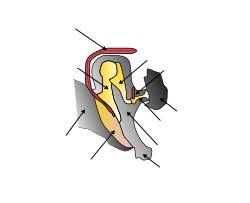MeSH A09.246.397.247.362 FMA 52752 | Latin Incus TA A15.3.02.038 | |
 | ||
Articulations | ||
The anvil or incus /ˈɪŋkəs/ is a bone in the middle ear. The anvil-shaped small bone is one of three ossicles in the middle ear. The incus receives vibrations from the malleus, to which it is connected laterally, and transmits these to the stapes, medially. The incus is so-called because of its resemblance to an anvil (Latin: Incus).
Contents
Structure
The incus is the second of the ossicles, three bones in the middle ear which act to transmit sound. It is shaped like an anvil, and has a long limb and a short limb that protrude from the point of articulation with the malleus.
Function
Vibrations in the middle ear are received via the tympanic membrane. The malleus, resting on the membrane, conveys vibrations to the incus. This in turn conveys vibrations to the stapes.
History
Incus means "anvil" in Latin. Several sources attribute the discovery of the incus to the anatomist and philosopher Alessandro Achillini. The first brief written description of the incus was by Berengario da Carpi in his Commentaria super anatomia Mundini (1521). Andreas Vesalius, in his De humani corporis fabrica, was the first to compare the second element of the ossicles to an anvil, thereby giving it the name incus. The final part of the long limb, was once described as a "fourth ossicle" by Pieter Paaw in 1615.
